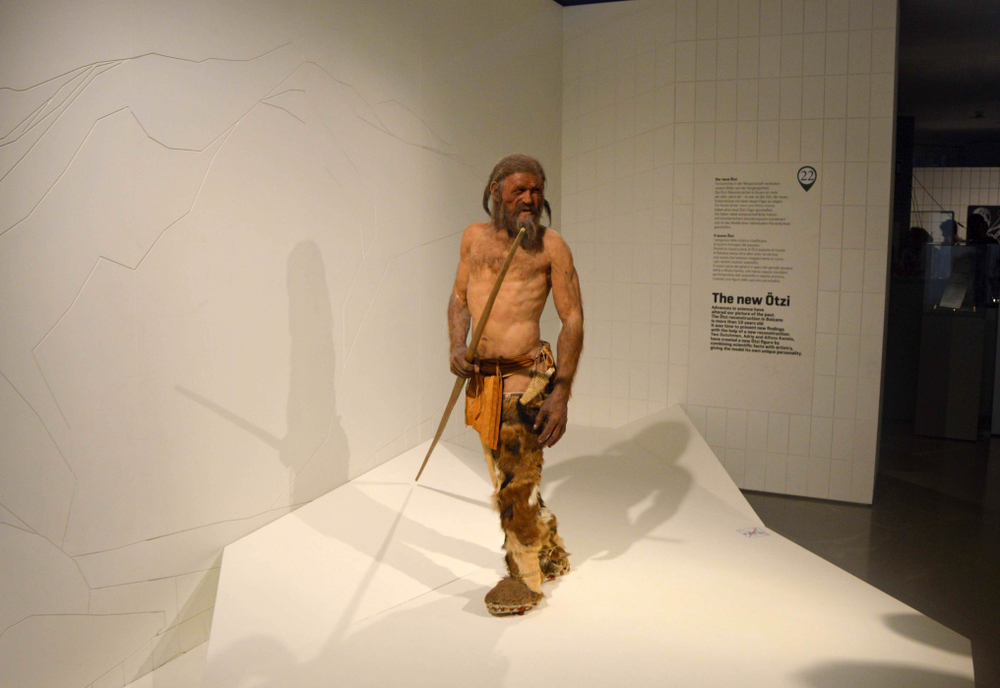A fresh genetic analysis has revealed more of the story behind Ötzi the Iceman, a remarkably well preserved human who perished in the Italian Alps around 5,300 years ago. As it turns out, the unfortunate mummy was closely related to the early farmers from Anatolia in modern-day Turkey who migrated here. Furthermore, his skin was much darker than previously thought and his head was most likely bald (provided the stresses and strains of Copper Age life had gotten to him).
The genome of Ötzi was first sequenced in 2012, indicating that Ötzi was related to the Steppe Herders who migrated from Eastern Europe. However, a new genetic analysis did not find any traces of this ancestry.
Instead, they found that had an “unusually high proportion” of genes in common with the early farmers from Anatolia. The inaccuracy, it seems, was the result of contamination from present-day human DNA.
“The first genome had 8 percent contamination from modern people. The new genome has almost no contamination,” Professor Johannes Krause, study author from the Max Planck Institute for Evolutionary Anthropology in Leipzig, told IFLScience.
This neatly fits in with the broader picture of Copper Age Europe. Hunter-gatherers in Western Europe merged with early farmers who migrated from Anatolia around 8,000 years ago. It wasn’t until 4,900 years ago – after Ötzi’s untimely death – that Steppe Herders from Eastern Europe migrated to Western Europe and gradually intermingled with the local population.
“Ötzi therefore is typical for his time, 5,300 years ago, in that he does not carry that type of [Eastern European Steppe Herders] ancestry,” Krause added. “Almost all Europeans that lived during the time of Ötzi had dark skin and almost all had a very high amount of Anatolian ancestry.”

We previously thought Ötzi looked like this, but the South Tyrol Museum of Archaeology might need to update their model.
Image credit: Zigres/Shutterstock.com
The frozen body of Ötzi was discovered in 1991 by two startled German tourists who were trekking up in the Ötztal Alps along the Austrian-Italian border. Thanks to extensive research into his remains, we have a pretty clear picture of his life. We know he was tattooed, had a dodgy heart, and was riddled with gut parasites. He most likely died after being shot with an arrow by an unknown assassin.
Surprisingly, the new research suggests that Ötzi had very dark skin. While it’s known that Europeans at the time did have fairly dark skin, the researchers say this is the darkest skin that’s ever been recorded in an ancient European.
“It’s the darkest skin tone that has been recorded in contemporary European individuals,” Albert Zink, study co-author and head of the Eurac Research Institute for Mummy Studies in Bolzano, said in a statement.
“It was previously thought that the mummy’s skin had darkened during its preservation in the ice, but presumably what we see now is actually largely Ötzi’s original skin color. Knowing this, of course, is also important for the proper conservation of the mummy,” explained Zink.
Likewise, it was previously thought that Ötzi’s mummy had no hair as it had degraded over the millennia. However, his genes suggest that he had a strong predisposition to male pattern baldness. Since he was around 45 years old when he died, it’s a safe bet that he no longer had a thick head of hair.
His genes also indicate that he was at an increased risk of obesity and type 2 diabetes. Fortunately for him, his lifestyle didn’t involve super-sugary sodas and donuts, plus he was very physically active, so it is unlikely to have impacted his health too severely.
The new study is published in the journal Cell Genomics.
Source Link: Ötzi The Iceman Mummy Was Bald And Had Surprisingly Dark Skin